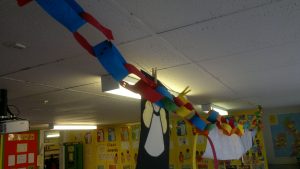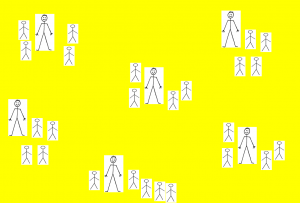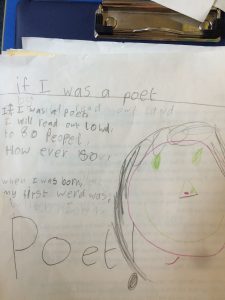Below are 10 ideas that I’ve found have been really effective in my class this year. Every class and every teacher is different, but I hope you might find one or two of these ideas inspire you a bit!
1. Find a New Friend Day:
Very simply, explain to the children that one day a week (Fridays are good) is now ‘Find a New Friend Day’ and that for this one day at play time they should try and find someone new to play with. All it takes is a little nudge from the teacher like this and you’ll see lots of new friendships blossoming. My class have really enjoyed this and I found ‘Find a New Friend Day’ was something I could mention to parents straight off the bat if the issue of friendships came up (it often does in Year 2, especially at the first parents evening).
2. Friendship Chain:
Children can take a slip of coloured paper and write something nice that they did with a friend on it. It can be that they made a new friend, they let someone play with them etc. I staple these links together and we now have a MASSIVE chain in class which is a great visual reminder for the children of how they’ve been kind to others. An end of year activity is going to be to take down the friendship chain and measure it in the hall! I’ve linked this to the above idea and on Fridays give my class a few minutes after lunch to write out friendship chains.
3. Worry Box:
I have a tissue box in my classroom with ‘Worry Box’ written on it. The children can take a small slip of paper and write anything that is worrying them and post it in the box for me to read. They can write things anonymously or put their name on. In response to what has been posted I’ll usually just have a quick talk with the class to address any issue raised.
Issues that were posted in my ‘Worry Box’ this year include:
—–
I’m worried I’ve lost my PE kit.
I’m worried about going into Year 3.
I’m afraid of the dark.
I can’t do spellings.
—-
I’ve found having a worry box is an easy way to catch issues which you might otherwise miss.
4. Simultaneous Show and Tell:
Possibly the idea that has made the biggest difference in terms of fitting everything into the day. Whenever I mention this to other teachers I’m usually met with ‘Oh I can’t believe I hadn’t thought of that!’
Basically rather than a show and tell where one child stands at the front and murmurs quietly away to 30 bored children, you have up to 8 children at a time scattered around your classroom ready with something to show. Everyone else (I call them all ‘listeners’!) gets to choose one person to go and listen to for one minute. When the minute is up the listeners thank the person who showed them something and move onto someone else. Repeat again and again until everyone has had a turn to see everything or until you run out of time!
What I love love LOVE about this idea is how flexible it is in terms of time AND how engaging it is. Children with something to show get to present several times in a row, getting better at presenting their item each time. Children who are listening are in a small group, have had some choice in who they are listening to and get to ask questions and see what is being presented close up. If you are pushed for time to get all your show and tell done (some weeks are busier than others!) you can use this activity and in the space of 5 minutes you can tick off 8 children that have had the chance to present something to their classmates two or three times!
5. Poem a day:
The idea that has made my class LOVE poetry. Every day after lunch we do the register and then I read a poem to the class. It takes just a minute or two a day. After that, we have a quick chat about the poem. Did you like it? Why? Why not? Sometimes I read a poem we’ve done before and sometimes I’ll bring in a new poem.
Just by doing this I now have a class of children that love to recite poems we’ve read together and that love to write their own poems! We’re near the end of the year now and I’ll say “Who wants to recite a poem?” and I’m greeted by a forest of hands! The children are reading poetry at home so they can come in and recite to the class! I know, I couldn’t flippin’ believe it either! ‘Please Mrs Butler’ by Allan Ahlberg is an amazing book of poetry for children, and anything by Michael Rosen.
6. Noun/verb/adjective/adverb morning register:
A quick little idea that gives you a chance to drill the class daily on some all-important grammar. In the morning every day I allow one child to choose a word class. Then when we do the register, each child has to say a word from that particular word class. We started with nouns, then branched out into verbs, then adjectives and then finally adverbs. I find doing this takes very little extra time and keeps these terms fresh in their minds.
7. Clap clap this this:
A very very simple no-resource needed clapping game which is great for building a bit of camaraderie in class and is especiall useful if you unexpectedly end up with a minute or two free at the end of a lesson. Children smile and have a laugh as they try and get the sequence right with a partner. When they’ve mastered the original sequence, they can then come up with their own clapping patterns. This idea really took on a life of its own when some children in my class figured out how to do this clapping game in groups of 3 or 4 or more! We even ended up with a bit of a hippie circle on the carpet made up of the entire class all clapping at the same time with the people on either side of them.
8. Art gallery mini-plenary:
I use this in almost every English writing lesson. After giving the children some input I’ll send them away to do some writing. After perhaps ten minutes, everyone stops writing and stands up behind their chair. We then do our ‘art gallery’ and everyone walks around in silence for a minute or so and looks at the writing that other children have done.
When time is up, everyone goes back and stands behind their chair again. Here’s the really clever bit:
I now choose someone at random. Whoever I choose has to say whose writing they liked and WHY. And they must be specific, no ‘errrr I liked the words’ allowed! If they can do this, then both they and the person whose writing they chose get a golden ticket! Doing this has been really effective in making sure everyone stays focused on looking at writing when they are walking round.
Higher-achieving children are proud when someone compliments their writing, and lower-achieving children get to see lots of examples of what they might want to try when they get back to their table. After spending just a minute or two on this ‘art gallery’, the children are always fired up with ideas and eager to continue their writing. As well as selecting a few children to comment on the writing of their classmates, I’ll often pick out a few children myself who I think have tried really hard or used a really interesting or engaging phrase.
What I like most about this idea is that is doesn’t need any resources or intricate organisation beforehand to implement. I use this activity so much in English that it’s become a standard part of our writing process, and the children have all gotten very good at giving positive and specific peer feedback.
9. Friday Quiz-Quiz-Trade:
Every Friday after lunch, we spend five minutes playing ‘quiz-quiz-trade‘ to recall facts that we’ve learned so far in Year 2. As we complete topics, I add in a few more cards to our ongoing quiz-quiz-trade deck. This has been great at ensuring every week we are still briefly reviewing past content and keeping it fresh in our minds.
The deck I have now is quite large and contains content from pretty much every subject, from telling the time to the Victorians and from facts about living and non-living things to times tables questions.
Top tip: Read this post here about a great way to differentiate quiz-quiz-trade cards, which is particularly useful for Maths.
Quiz-quiz-trade is a Kagan structure, which is (in my opinion) a really excellent style of cooperative learning.
10. Exit Slips:
Exit slips seem to be a bigger thing in the US than in the UK, but I’ve found them a great little method through which I can check the level of understanding at the end of a practical lesson. Essentially you have a stack of small pieces of scrap paper ready. At the end of a lesson where the children have been doing paired or group work or something hands-on, you set them a final problem on the board which they answer by themselves ALONE. When they are done, they fold over their piece of paper and write their name on it and give it to you (I have my class leave their exit slips on my chair as they go out to play). You can quickly go through the slips after the lesson has finished and catch any little misconceptions or mistakes and be ready to address them next lesson.
I tend to use exit slips a lot in grammar lessons or in Maths, where there is quite a clear single-lesson learning objective being covered. I’ll put a few differentiated questions up on my smartboard for children to answer in the last ten minutes of the lesson. Time permitting, I’ll often give any extra feedback needed right as they bring their completed exit slip to me. Children who’ve ‘got it’ can be sent to the challenge area to challenge themselves for the last 1o minutes, while any child who needs a bit of extra support can be spoken to there and then. I’ll sometimes ask a child who ‘got it’ to speak to a child who needs a bit more support and ask them to talk through things together.
I particularly like exit slips because they build in some individual accountability to lessons with pair or group learning, encouraging children to engage their brains and take part rather than perhaps trying to coast on the efforts of others! The fact that the exit slip is a small piece of paper means it’s easy for a child to cover up with one hand, which discourages copying. Also, the children are bringing you their answers as soon as they are done, meaning there aren’t any completed answers left hanging around temptingly on tables near to children who might not be able to resist the urge to copy them!
Currently I don’t tend to stick exit slips in books as that’s not really what they are for and because they can be a bit messy-looking. I am however looking into finding someway of making exit slips that can be stuck in books in the future (like the one pictured), just so there’s some nice clear evidence of what a child could achieve in a particular lesson for anyone who checks their book to see.







Brilliant ideas. I’m 14 years in and have picked up some great ideas! Thank you
These are great! Thank you so much for sharing. I’m moving to Year 2 next year for the first time and as I start to think about what next year will look like, I can use these ideas to shape my lessons/day.
LOVE the idea of the art gallery mini plenary!